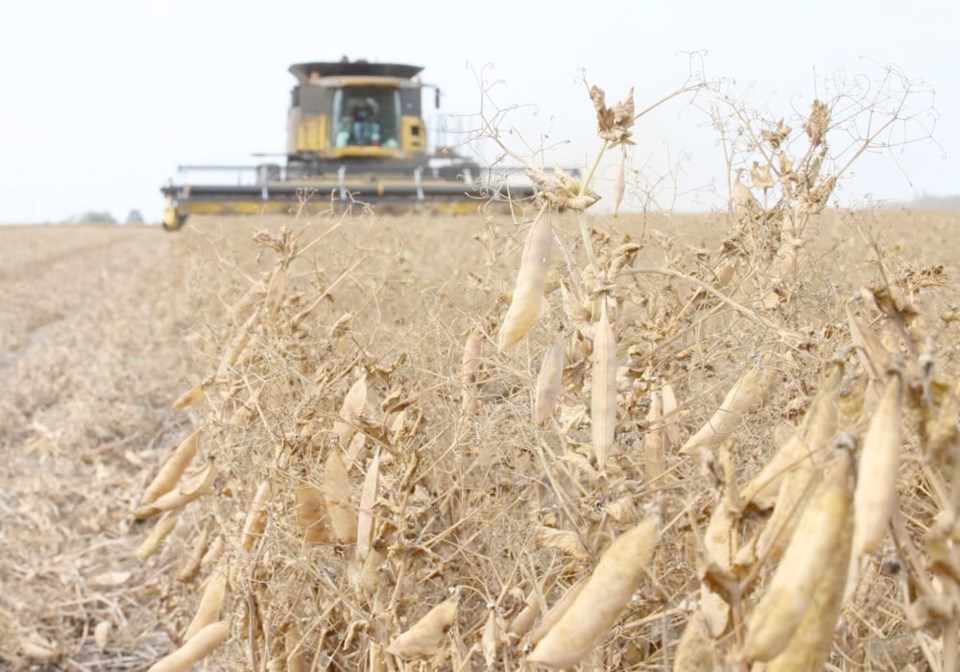WESTERN PRODUCER — The first Canadian pea and lentil yield estimates are out, and they are not encouraging.
Chuck Penner, analyst with LeftField Commodity Research, provided his initial forecast in a July 31 article he wrote for Alberta Pulse Growers’ Pulse Market Insight publication.
He based his estimates on crop ratings provided by Alberta Agriculture and Saskatchewan Agriculture at that time.
LeftField is forecasting a national average pea yield of 33 bushels per acre, which is 11 percent below the Olympic five-year average, but still well above the 22 bu. seen in 2021.
“The rationale for keeping our guesstimate closer to average than 2021 is that the 2023 season hasn’t seen the same extreme heat as 2021 and conditions seem to be more stable, not dropping as hard as they did in 2021,” said Penner.
Leftfield is forecasting an average lentil yield of 1,130 pounds per acre, 15 percent less than the Olympic average but “considerably better” than the 2021 yield of 850 lb.
But crop condition ratings have worsened considerably since his article was published.
Saskatchewan’s latest estimate is 32 percent of the pea crop is in good-to-excellent condition, while Alberta’s is 45 percent.
That is down from 50 percent for both provinces at the time of Penner’s article, which was already well below the 10-year average of 68 percent.
The current lentil ratings are 29 percent good-to-excellent for Saskatchewan and 37 percent for Alberta, down from 44 and 50 percent when Penner wrote his article.
AgPulse Analytica also forecasts a small Canadian pea crop, noting that soil moisture levels in Saskatchewan are at the lowest levels in more than a decade.
AgPulse analyst Gaurav Jain believes the crop will be smaller than the 2.9 million tonnes Agriculture Canada forecast in its July estimate, which would be 11 percent below last year’s harvest.
“With a 10 percent decrease in acreage, the lowest soil moisture in a decade and falling normalized difference vegetation index, our yield model puts a production figure of 2.52 million tonnes in the realistic scenario,” he said in a market update he wrote for the Global Pulse Confederation.
“However, a pessimistic scenario, with continued low precipitation over the next three to four weeks, puts the production at just 1.78 million tonnes.”
A huge crop in Russia will offset Canada’s short crop, because of a 17 percent increase in seeded acreage.
“The pea harvest is underway and early yields are pointing to a normal year,” Jain said in a separate GPC article.
That should result in 4.1 million tonnes of production. Carry-out stocks will push 2023-24 supplies to five million tonnes.
“Russia is in a position to meet any shortfall in North America,” he said.
He forecasts 2.05 million tonnes of Russian exports, with the key markets being China, Turkey, Spain, Italy and Bangladesh.
“The world supplies of yellow peas remain stable, thanks to a large Russian crop,” said Jain.
Stat Publishing is forecasting 570,000 tonnes of Canadian pea carryout from the 2022-23 crop. That will likely fall to 387,000 tonnes by the end of this year.
That forecast is based on a four percent drop in pea yields, which is well below Penner’s estimate.
“The key concern facing Canadian and U.S. exporters as the 2023-24 marketing year gets underway is the degree of competition they will face from Russia, which is demonstrably price competitive in a growing number of market destinations,” Stat publisher Brian Clancey said in a recent article.
Stat forecasts 135,000 tonnes of lentil ending stocks, with about 16,300 tonnes of that in farmers’ hands, the lowest level since 2009.
“The lower the ending stocks number, the bigger problem faced by Canada in the coming season,” said Clancey.
“There is a general expectation yields will be below average in Canada, but that overall quality will be good, with the harvest readily meeting a No. 2 Canada grade standard.”
He said there could be a shortage of large green lentils this year, which could result in a price premium for that class.
Contact [email protected]
You can no longer count on social media to deliver important news to you. Keep your news a touch away by bookmarking SASKTODAY.ca's homepage at this link.
Here's why you should bookmark your favourites.




